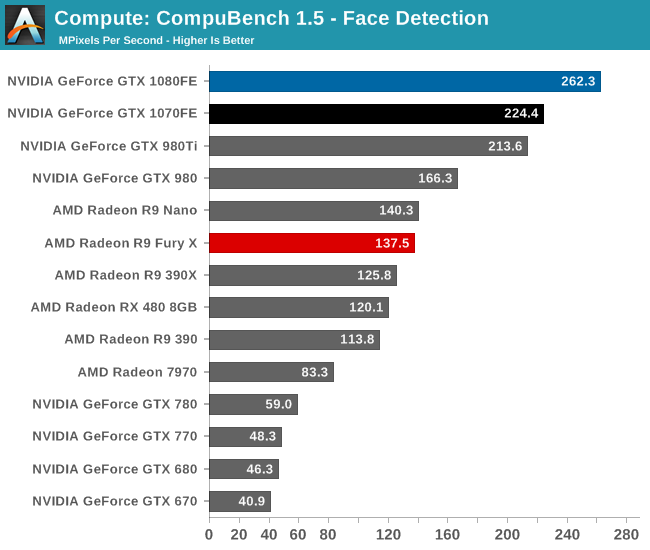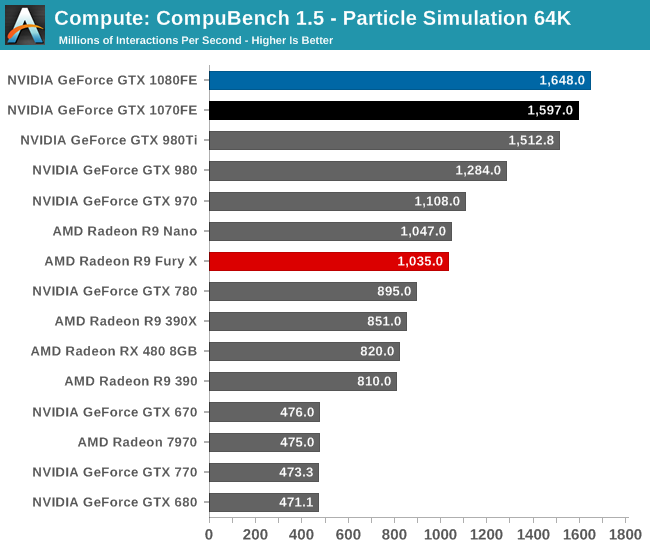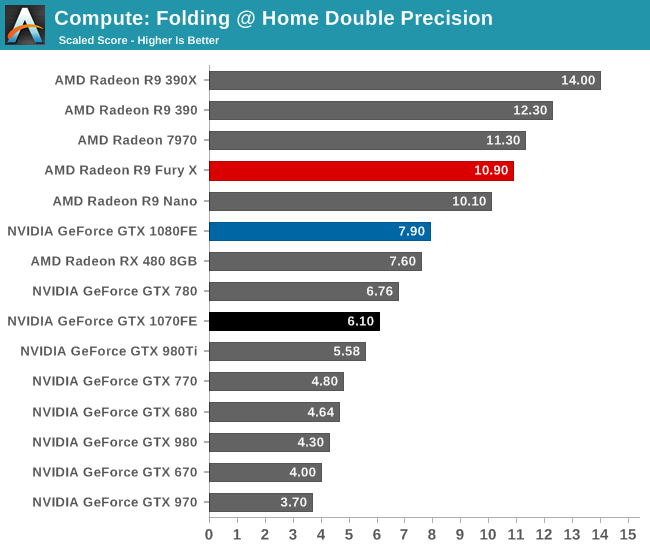The NVIDIA GeForce GTX 1080 & GTX 1070 Founders Editions Review: Kicking Off the FinFET Generation
by Ryan Smith on July 20, 2016 8:45 AM ESTCompute
Shifting gears, let’s take a look at compute performance on Pascal.
Overall, we’re not expecting a significant difference in compute performance compared to Maxwell 2 for standard compute benchmarks. The fundamental architecture hasn’t changed – the CUDA cores, register files, and caches still behave as before - so there’s little reason for compute performance to shift. GP104 for all intents and purposes should perform like a higher clocked and slightly wider Maxwell 2, similar to what we’ve seen in most games.
However in the long run there is potential for Pascal to show some improvements. The architecture’s improved scheduling features are geared in part towards HPC users, and instruction level preemption means that compute kernels can now be a lot more aggressive on consumer systems since they can be paused so easily. That said, to really leverage any of these improvements, applications utilizing GPU compute need to have work that benefits from better scheduling and be written with Pascal in mind, and for consumer workloads the latter is likely a long way off.
Starting us off for our look at compute is LuxMark3.1, the latest version of the official benchmark of LuxRender. LuxRender’s GPU-accelerated rendering mode is an OpenCL based ray tracer that forms a part of the larger LuxRender suite. Ray tracing has become a stronghold for GPUs in recent years as ray tracing maps well to GPU pipelines, allowing artists to render scenes much more quickly than with CPUs alone.

As with games, when it comes to LuxMark, the GTX 1080 is uncontested; this is the first high performance FinFET GPU in action. That said, I’m surprised by how close some of these results cluster. Though GTX 1080 is not a full generational replacement for GTX 980 Ti, normally it outperforms the Big Maxwell card by more than this. Instead we’re looking at a lead of just 10%, notably less than a simple extrapolation of CUDA core counts and frequencies would tell us to expect (GTX 1080 has almost 50% more FLOPs).
That said, GTX 1070 still places very close to GTX 980 Ti – albeit below it – so what we’re seeing isn’t just Pascal being a laggard. Especially since as a consequence of this, GTX 1080 only beats GTX 1070 by 12%. In any case, this may be a case of early drivers, particularly as OpenCL has not been an NVIDIA priority for the last couple of years. Alternatively, as strange as it may be, I’m not ready to rule out LuxMark being CPU limited. It’s something that we’ll have to keep an eye on.
For our second set of compute benchmarks we have CompuBench 1.5, the successor to CLBenchmark. CompuBench offers a wide array of different practical compute workloads, and we’ve decided to focus on face detection, optical flow modeling, and particle simulations.



Depending on which sub-test we’re looking at, CompuBench is all over the place. In Face Detection the GTX 1080 takes a commanding lead, with GTX 1070 easily slotting into second place. On the other hand we have Optical Flow, which NVIDIA cards have traditionally struggled with, where even GTX 1080 can’t unseat Radeon Fury X. Finally in the middle we have the 64K Particle Simulation, which has GTX 1080 in the lead again, but not unlike LuxMark, it also has some interesting clustering going on.
Ultimately each test stresses our GPU collection in different ways, which as we can see greatly influences how the results pan out. Face Detection has always played well to NVIDIA’s strengths, and on a generational basis we get solid scaling from Maxwell 2 to Pascal. Even Optical Flow, which seems to favor raw FLOPs more than anything else, still shows very good gains with Pascal.
Particle Simulation is the outlier in this regard; Pascal’s generational gains are not insignificant, but they’re less than what we’d expect. Furthermore GTX 1080 and GTX 1070 are very closely clustered together despite their much larger difference in FLOPs. This may mean we’re looking at a CPU or driver bottleneck, or possibly some sort of internal path bottleneck. GTX 1080 has more FLOPs and a similar advantage in memory bandwidth, but once you get on chip things get much closer. If nothing else this goes to show that compute benchmarks are much more architecture sensitive than games, which is why we can’t make very broad generalizations for all compute workloads.
Moving on, our 3rd compute benchmark is the next generation release of FAHBench, the official Folding @ Home benchmark. Folding @ Home is the popular Stanford-backed research and distributed computing initiative that has work distributed to millions of volunteer computers over the internet, each of which is responsible for a tiny slice of a protein folding simulation. FAHBench can test both single precision and double precision floating point performance, with single precision being the most useful metric for most consumer cards due to their low double precision performance. Each precision has two modes, explicit and implicit, the difference being whether water atoms are included in the simulation, which adds quite a bit of work and overhead. This is another OpenCL test, utilizing the OpenCL path for FAHCore 21.


In single precision performance, to the surprise of no one the GTX 1080 is solidly in the lead, followed up by the GTX 1070. On a generational basis performance gains are decent, but at 44% for GTX 1080 they aren’t quite as great as we’ve seen from the card elsewhere. Meanwhile the two Pascal cards are again closer than we’d expect, with GTX 1080 leading by only 10%.
As for double precision performance, we can see that even with the higher overall compute throughput of GP104, it still can’t make up for the fact that FP64 performance on the GPU is capped at 1/32 by virtue of so few FP64 CUDA cores, which puts even NVIDIA’s latest and greatest at a disadvantage here. But if nothing else, generational scaling versus Maxwell 2 looks very good, with performance gains closely tracking the theoretical increase in FLOPs.










200 Comments
View All Comments
bill44 - Friday, July 22, 2016 - link
That's the problem. I know nothing about the 900 series audio capabilities (which I suppose is the same as the 800 series ;) ) and no one publishes them in review. All reviews are incomplete.Anyone here knows at least the supported audio sampling rates? If not, I think my best bet is going with AMD (which I'm shure supports 88.2 & 176.4 KHz).
bill44 - Saturday, July 23, 2016 - link
Anyone?poohbear - Wednesday, July 20, 2016 - link
thank you for the review, late as it is it's still an excellent review and love the details!junky77 - Wednesday, July 20, 2016 - link
In other reviews, even a Haswell-E is limited for GPUs like GTX 1070JamesAnthony - Wednesday, July 20, 2016 - link
I really appreciate all the work that went into this in depth review.I especially am very glad that you included the GTX 680 in the benchmarks along with all the other cards after it.
It's often really hard to get an overview of performance over a couple years.
I'm looking at upgrading 2 systems from GTX680 to either GTX 1070 or GTX 1060 and Titan (original one) to GTX 1080, so this helps see what the performance would be like.
Hopefully you tested the 1060 the same way so I can just plug the numbers for it into the same graph.
Thanks again!
Ryan Smith - Wednesday, July 20, 2016 - link
Be sure to check Bench. The 1060 results are already there, so you can see those comparisons right now.fivefeet8 - Wednesday, July 20, 2016 - link
2nd page 3rd paragraph: "generational increate in performance". ;increase?2nd page 2nd section: "Pascal in an architecture that I’m not sure has any real parallel on a historical basis". ;is?
hansmuff - Wednesday, July 20, 2016 - link
Great review, i like that you went into all the hardware details. Worth the wait.Chaser - Wednesday, July 20, 2016 - link
I'm a Nvidia guy all the way. For now. I am disappointed in the midrange RX480 and it's power consumption compared to the competition, especially after they had said that Polaris was goingto primarily be an efficiency improvement.Outside of my bias I truly hope AMD provides a very competitive flagship in the near future. Everyone wins. But with the 1060 now announced it just makes AMD's GPU prospects and profitability questionable.
MarkieGcolor - Wednesday, July 20, 2016 - link
So basically after all the hype about finfet, we get a standard, if not disappointing jump this generation also with a price hike. I'm so relieved that I didn't wait for this generation and can just enjoy my current 970 sli/nano crossfire rigs. AMD easily has the opportunity to blow these cards out of the water with big gpus.